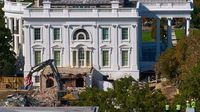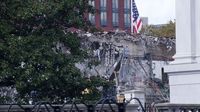On October 23, 2025, the White House East Wing—long a symbol of American history and the operations of First Ladies—was reduced to rubble. The demolition, carried out as President Donald Trump pressed forward with his plan to build a new, 90,000-square-foot ballroom, has ignited fierce debate across Washington and the nation. Photos from the Associated Press showed the two-story structure, once home to drawing rooms, offices, and the famed Jacqueline Kennedy Garden, completely leveled in a move that has both supporters and critics speaking out in equal measure.
The ballroom project, initially announced in July with a price tag of $200 million, has seen its estimated cost balloon to roughly $300 million, with Trump himself updating the figure in a press conference on October 23. By the end of that day, Trump claimed that $350 million had been raised for the endeavor, stating, “I’ll donate whatever is needed,” though he remained vague about his own contribution. The president insisted that the project would not cost taxpayers a dime, saying, “I and some friends of mine will pay for the ballroom at no cost to taxpayers.”
Despite Trump’s assurances, the abrupt demolition—commenced without advance warning and during a government shutdown—has drawn sharp criticism from preservationists, lawmakers, and members of the public. According to Courthouse News, a lawsuit was filed the same day in the U.S. District Court for the District of Columbia by Charles and Judith Voorhees. The suit seeks a temporary restraining order to halt further construction until the National Capital Planning Commission completes a public review process. However, as The Washington Post reported, the East Wing was already demolished by the time the suit was filed.
The legal complaint alleges that the Trump administration violated both the National Capital Planning Act of 1952 and the National Historic Preservation Act by bypassing required reviews and consultations for such a significant alteration to a protected national landmark. The plaintiffs argue, “Defendants are unilaterally decoupling the demolition of the East Wing of the White House from the construction approval process to expedite the project, effectively bypassing the historic preservation and planning reviews required under federal law for a project of this magnitude on a protected national landmark.”
White House Press Secretary Karoline Leavitt, responding to mounting questions, explained that the demolition and increased costs were due to necessary changes for a modern and stable structure. She asserted that the planning commission “does not have oversight over demolition projects, only vertical construction requires review.” Leavitt assured the public that “the plans changed when the president heard counsel from the architects and the construction companies who said that in order for this East Wing to be modern and beautiful for many, many years to come, for it to be a truly strong and stable structure, this phase one that we’re now in was necessary and the president wants to do right by the ‘People’s House.’”
Yet, the lack of transparency has only fueled the controversy. The National Trust for Historic Preservation expressed deep concern, warning in a letter to the National Capital Planning Commission, the National Park Service, and the Commission of Fine Arts that the size of the proposed ballroom—nearly twice the size of the White House itself—could permanently disrupt the Executive Mansion’s classical design. Carol Quillen, president and CEO of the Trust, stated, “We respectfully urge the administration and the National Park Service to pause demolition until plans for the proposed ballroom go through the legally required public review process, including consultation and review by the National Capital Planning Commission and the Commission of Fine Arts, both of which have authority to review new construction at the White House, and to invite comments from the American people.”
Amid the legal wrangling and public outcry, the political implications have come to the fore. Republican lawmakers have largely backed Trump’s decision, framing it as a matter of presidential prerogative and private funding. Senator Markwayne Mullin (R-Okla.) said, “I think it’s awesome. The president has an unbelievable eye for detail and construction. Obviously, he’s great at it, and he’s making the White House into, I think, what the people around the world’s expectations are.” Senator Ron Johnson (R-Wisc.) added, “It’s not like it’s sacrosanct.” House Majority Leader Steve Scalise (R-La.) emphasized that Trump’s work ethic and the use of private funds set the project apart, saying, “President Trump’s made it clear, even during a government shutdown, he’s gonna keep working.”
Democrats, by contrast, have seized on the demolition as a symbol of what they see as Trump’s disregard for democratic norms and public priorities. Senator Alex Padilla (D-Calif.) remarked, “He’s trying to tear down the rule of law, trying to tear down our democratic institutions, he’s trying to tear down the hopes and dreams of so many. He’s tearing down the economy, and now he’s tearing down the East Wing of the White House.” Senate Minority Leader Chuck Schumer (D-N.Y.) was equally pointed, declaring on the Senate floor, “Donald Trump is telling the American people: no Medicaid for you, ballroom for me.” Schumer further criticized the president for focusing on vanity projects instead of health care, saying, “They only benefit Trump and his ego.”
The optics of the project—especially during a government shutdown affecting millions of Americans—have proven especially contentious. Senator Lisa Murkowski (R-Alaska) acknowledged, “There’s a conflict in just the reality that people are seeing. They’re seeing the impact of a government shutdown on them and their families that is personal and with potential for really harmful impacts. And then they see Washington: Business as usual. We’re voting on judges and the East Wing of the White House is being taken down for a massive ballroom.”
Questions about transparency have only intensified as the White House released a partial list of donors to the ballroom project, which includes major corporations such as Amazon, Alphabet, Lockheed Martin, Microsoft, Palantir, and T-Mobile. However, full details regarding private donations and individual contributions remain unclear. The president himself has not disclosed how much he is personally contributing, and the process by which construction companies were selected has also come under scrutiny.
The East Wing, until recently, served as the base of operations for the First Lady and her staff, the social office, military office, and the visitors’ office. It was also the main entry point for public tours and events, including state dinners and receptions. All such activities were halted in late summer to prepare for construction, with operations temporarily relocated elsewhere on the White House campus. The building also sat atop an emergency bunker and wrapped around the Jacqueline Kennedy Garden. Several trees on the South Lawn have already been cut down as part of the process.
Public reaction has been mixed. Some tourists, like Erich Habelt of California, expressed support, saying, “It’s his house. He can do with it, you know, he’s spending his money and not my taxpayer money. It’s OK with me. And as with any old house, things need to be renovated.” Others, like Herb Hutchison of Alabama, pointed out that past presidents have also added to the White House, noting, “I don’t see it as any more than making something better than it was before.” Yet, a YouGov poll released on October 22 found that 53% of Americans strongly or somewhat disapprove of the East Wing demolition.
As the dust settles—literally and figuratively—over the White House lawn, the future of the Executive Mansion’s east side remains uncertain. Whether the new ballroom will become a celebrated addition or a lasting source of controversy is a question that only time, and perhaps future administrations, will answer.

